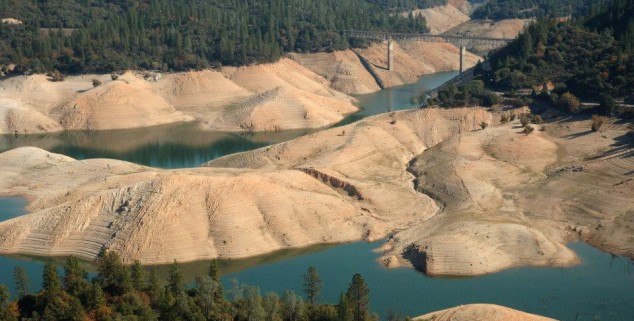News
Drought emergency: The need for a biodiversity policy
 Lake Oroville ravaged by drought. (Photo: State Department of Water Resources, 2014)
Lake Oroville ravaged by drought. (Photo: State Department of Water Resources, 2014)(Ed’s Note: The following is the latest in a series of articles on California water issues from experts convened by the UC Davis Policy Institute for Energy, Environment and the Economy).
California ecosystems are losing their resilience and their ability to sustain native plants and animals http://bambawefushia.com/damer-i-norge/. In the past, even in droughts, there were natural refuges to sustain native species. Today, most of these ecosystems are changing rapidly from human impacts and many have deteriorated to critical condition. Refuges are scarce.
This is especially true for aquatic ecosystems. Native fish populations have plummeted, some approaching extinction. Wetlands for waterbirds are shrinking. Almost all groups of aquatic organisms have endangered species. For every species known to be at risk, many more are struggling invisibly.
The solution is a California drought biodiversity strategy, especially for aquatic species and habitats.
Because we were poorly prepared for this environmental emergency, most federal and state drought rescue measures have been directed at helping water users in cities and on farms, with a few valiant efforts made to protect some fishes.
We can do better. Fortunately, we know how to substantially improve conditions for many of our most at-risk organisms and associated species. In the process, we will even do some good for the not-endangered species at the top of the hill: ourselves.
The solution is a California drought biodiversity strategy, especially for aquatic species and habitats. We could start to write such a strategy tomorrow if the political will was present – we already have the necessary federal and state policy and regulatory framework. We just need a plan with specific triggers and actions.
A drought biodiversity strategy backed by top public officials would give the environment a place at the table when regulators divide up limited water resources. It might not give the environment all the water it needs, or even as much as other user classes get. But it would mandate that California’s environment get the same consideration as its households, industry and agriculture.
Dividing up scarce water resources is a challenging and politically difficult task. For example, in the past two years, the State Water Resources Control Board made emergency exceptions to environmental protections for fish and water quality so they could shift more Sacramento-San Joaquin Delta water to farms and cities.
Would people save more if they knew the saved water would go to fish, birds and plants in wildlife refuges or to improve flows in streams?
Economically, there are downsides to not allocating sufficient water for environmental purposes. More endangered species means more legal barriers to sharing the water among urban, agricultural, and environmental sectors.
What if, instead, a drought biodiversity strategy had required that the people who got the additional water had to buy it? In a drought year, 40,000 acre-feet of water south of the Delta might be worth as much as $1,000 an acre-foot. That’s $40 million to spend on other measures to protect native species. Would farmers and municipal water suppliers pay that, or might they conserve more instead? Either way, the environment could win.
Other provisions that a drought environmental strategy could include are:
Encourage conservation by dedicating saved water to wildlife. Currently, most household water conservation frees up water for other local users, or other thirsty cities and farms served by federal, state, and local water projects. Would people save more if they knew the saved water would go to fish, birds and plants in wildlife refuges or to improve flows in streams? Public polls suggest they might, so why not try an experimental program?
Get the most benefit from limited supplies. Researchers at 10 universities, government agencies and conservation organizations recently mapped California freshwater species hotspots, using data about more than 2,200 plants and animals that are at risk for extinction. A drought environmental strategy could make these hotspots priorities. In this rapidly changing world, every native species should have a home and someone in authority who is designated to make sure the home remains standing.
Improve environmental flows below dams. Most rivers in California are regulated by over 1,400 large dams. New research says flow releases from the dams could be adjusted at many of them to provide improved conditions for declining fishes and fisheries. If a smart ”natural” flow regime was adopted, water costs would not have to be high, as flows down Putah Creek to enhance native fishes below Monticello Dam demonstrate.
—
Ed’s Note: Peter B. Moyle is Distinguished Professor Emeritus in the Department of Wildlife, Fish and Conservation Biology and associate director of the Center for Watershed Sciences at the University of California, Davis.
Want to see more stories like this? Sign up for The Roundup, the free daily newsletter about California politics from the editors of Capitol Weekly. Stay up to date on the news you need to know.
Sign up below, then look for a confirmation email in your inbox.

Peter moyle is a puppet of the radical left agenda. He ignores science when it comes to trout and has picked and choosen his research papers to suit his radical agenda. He would rather kill all the largemouth bass , sunfish, catfish in flourishing lakes and reservoirs and all of the birds and enormous biodiversity they support for 40 rainbow trout. I wish he would just shut up and your moustaches looks stupid